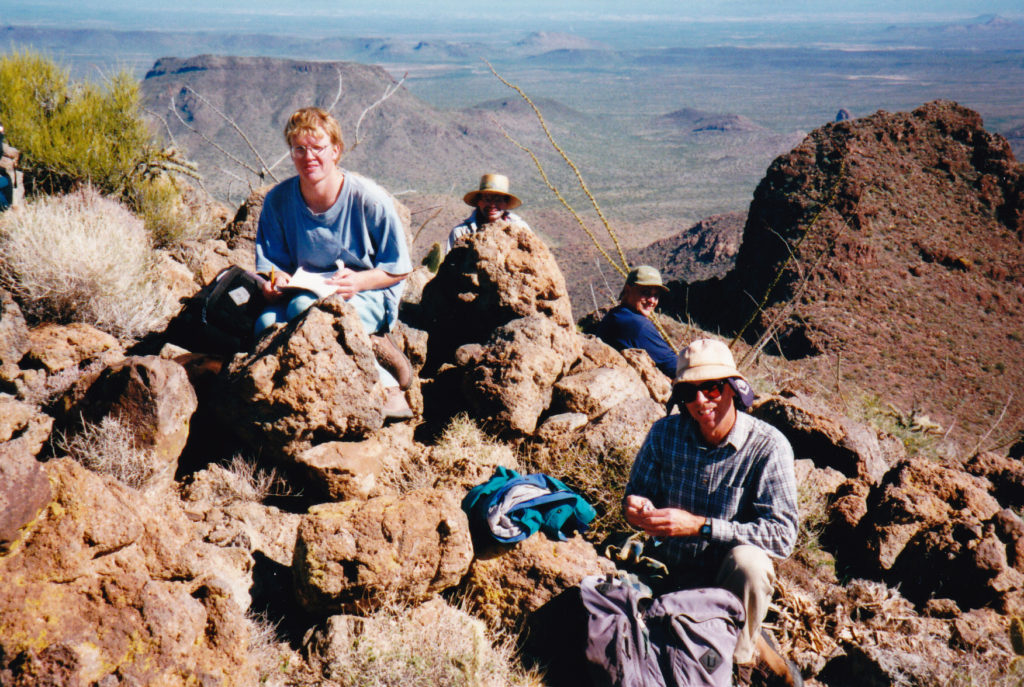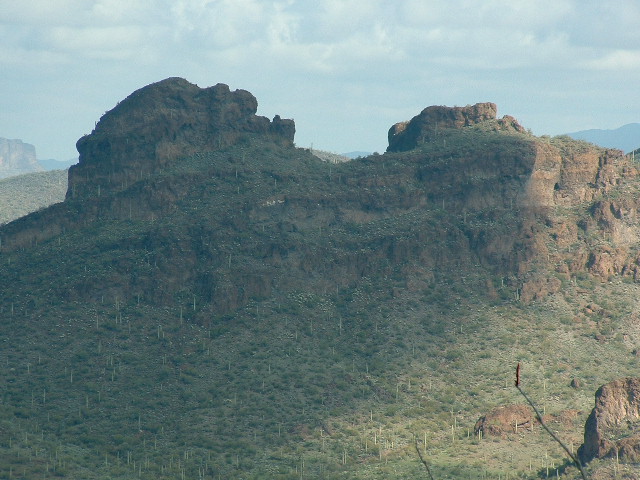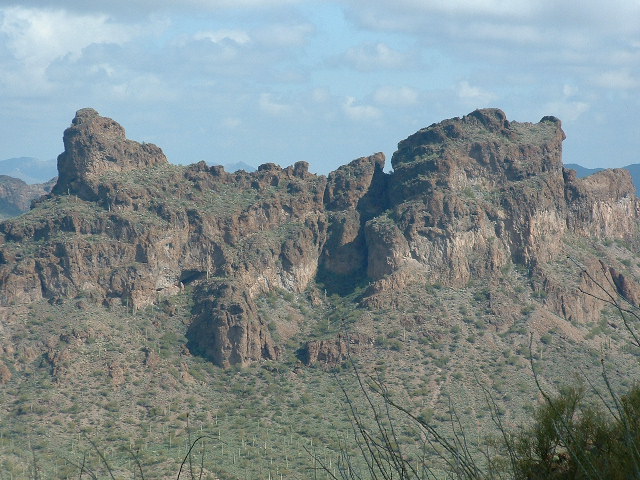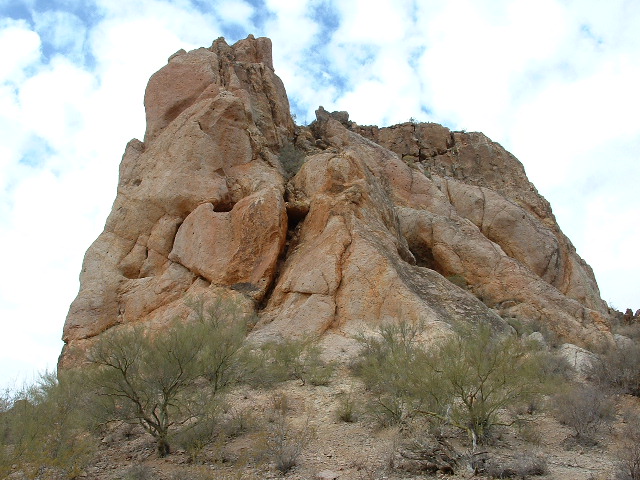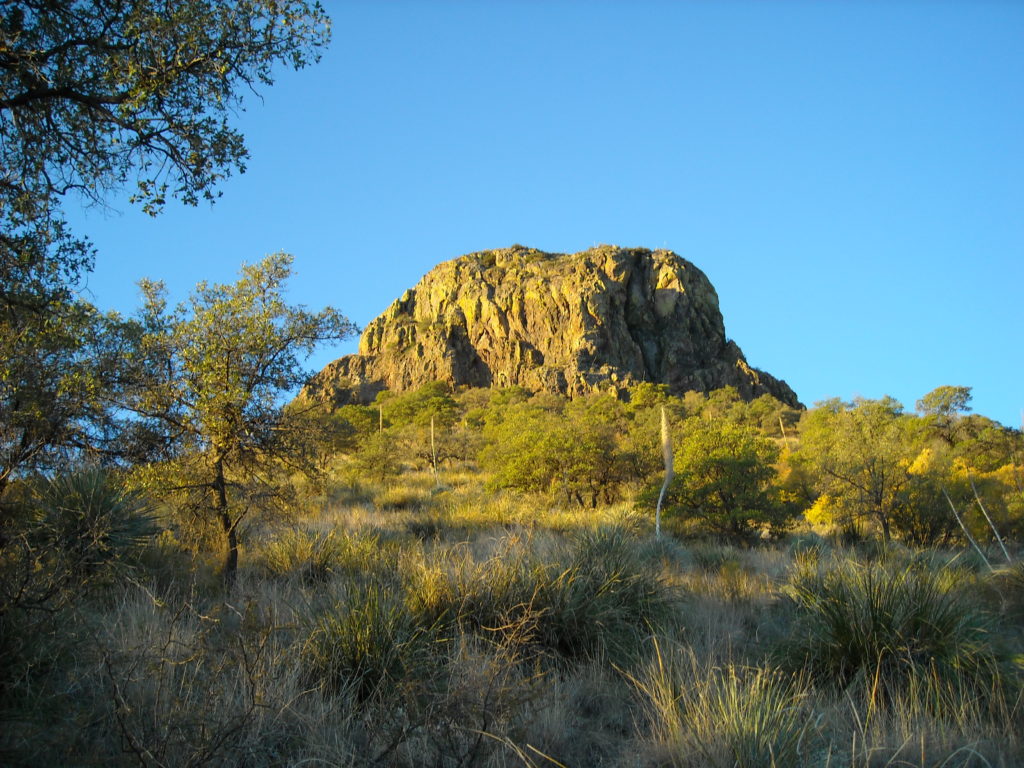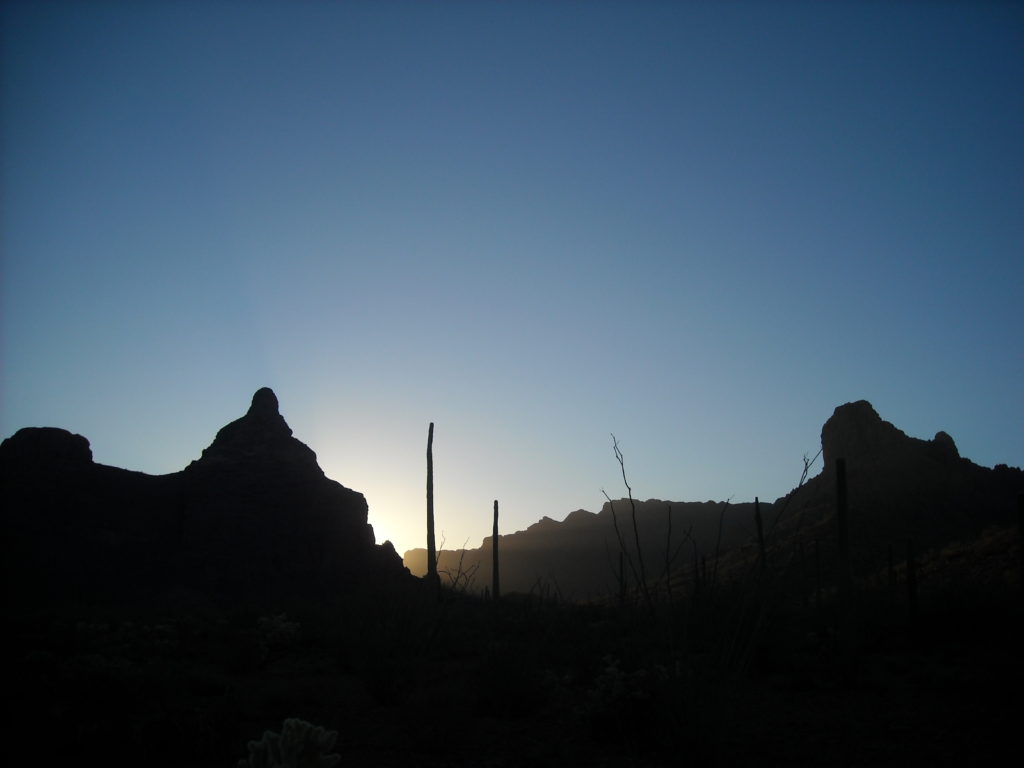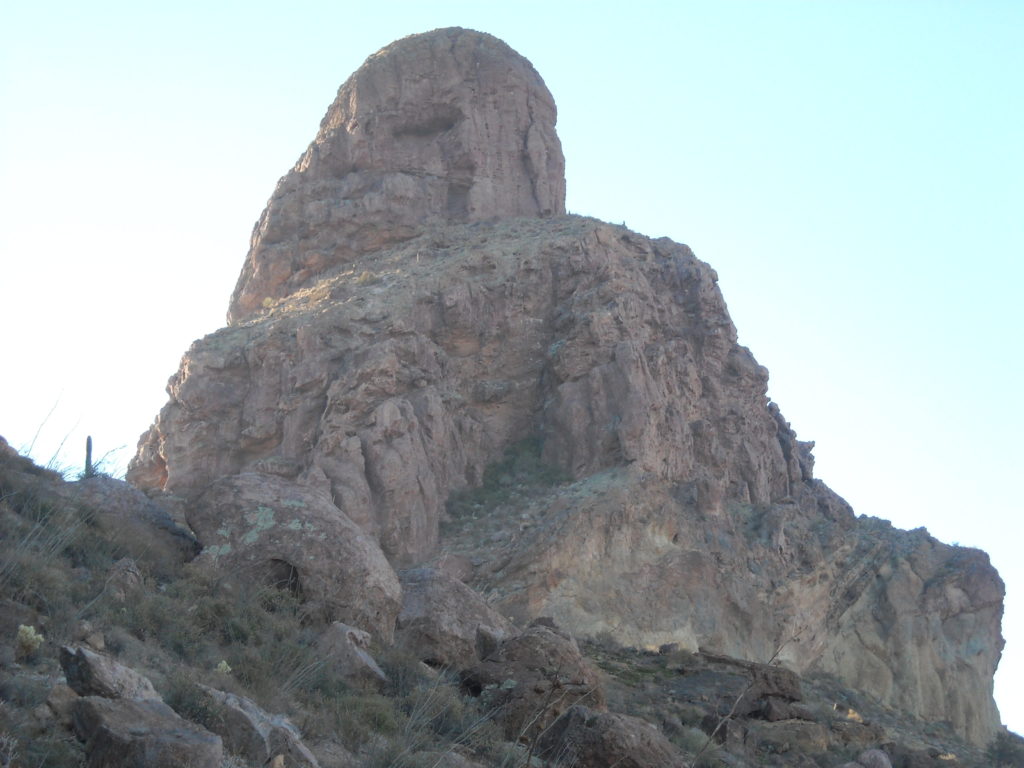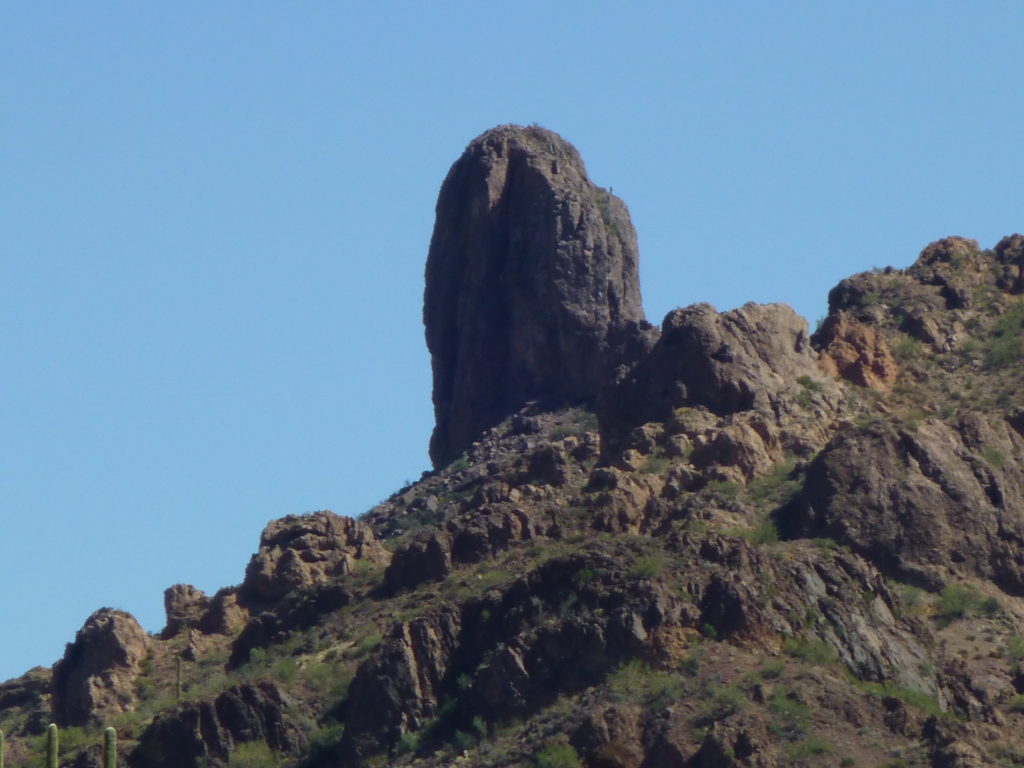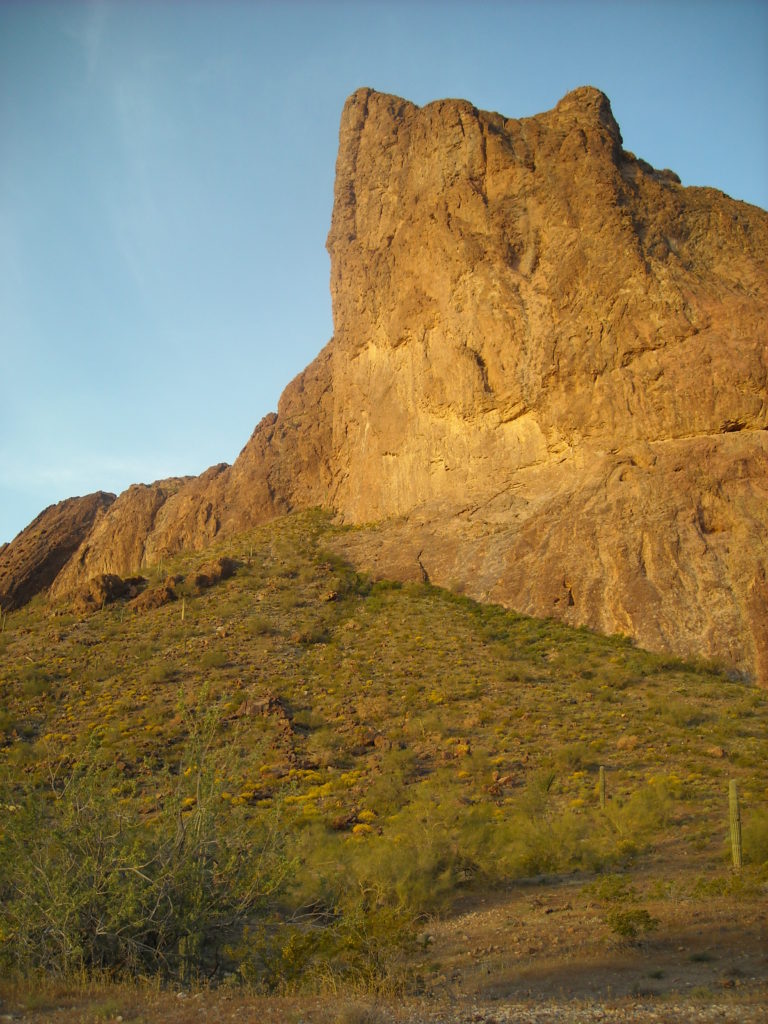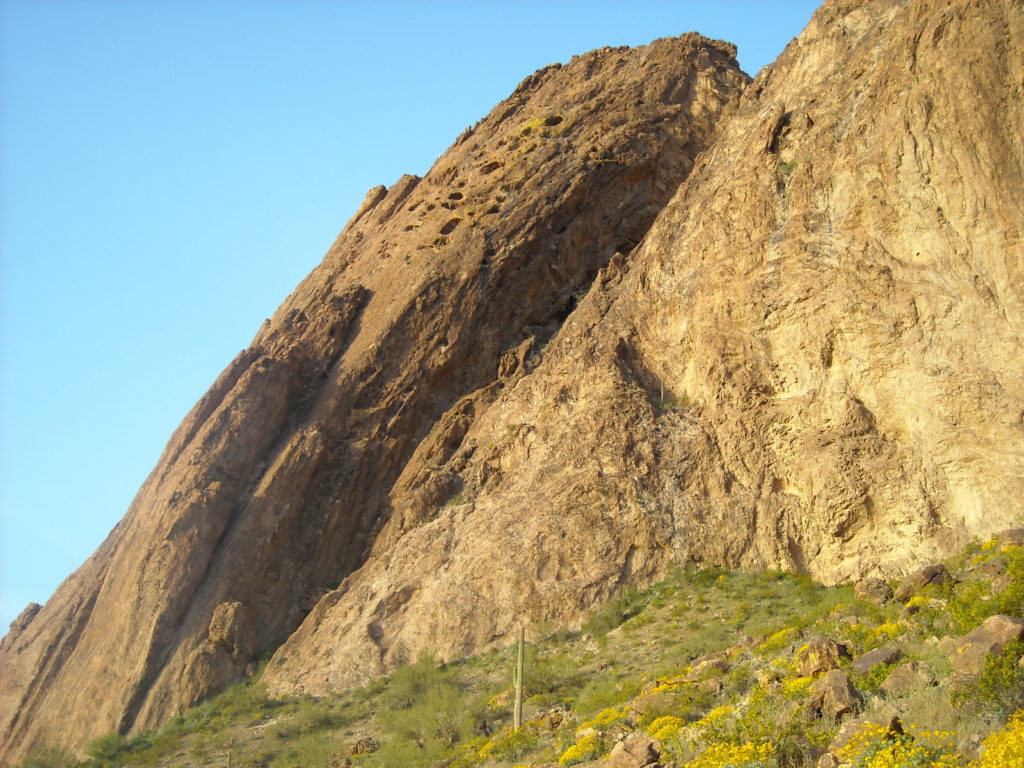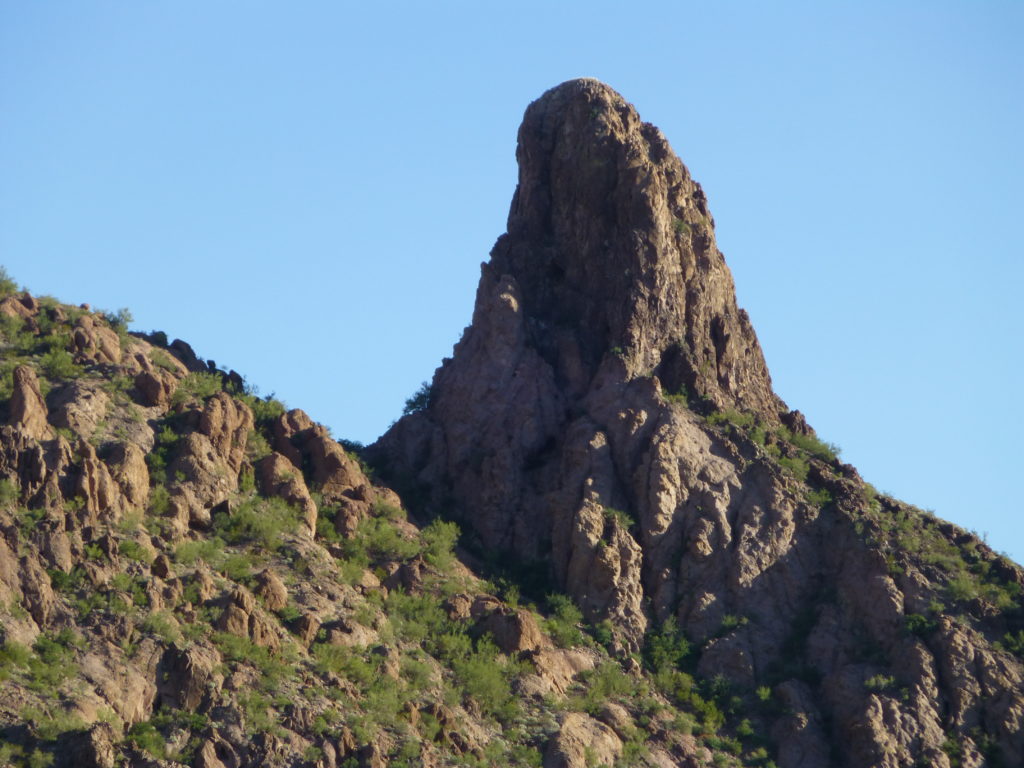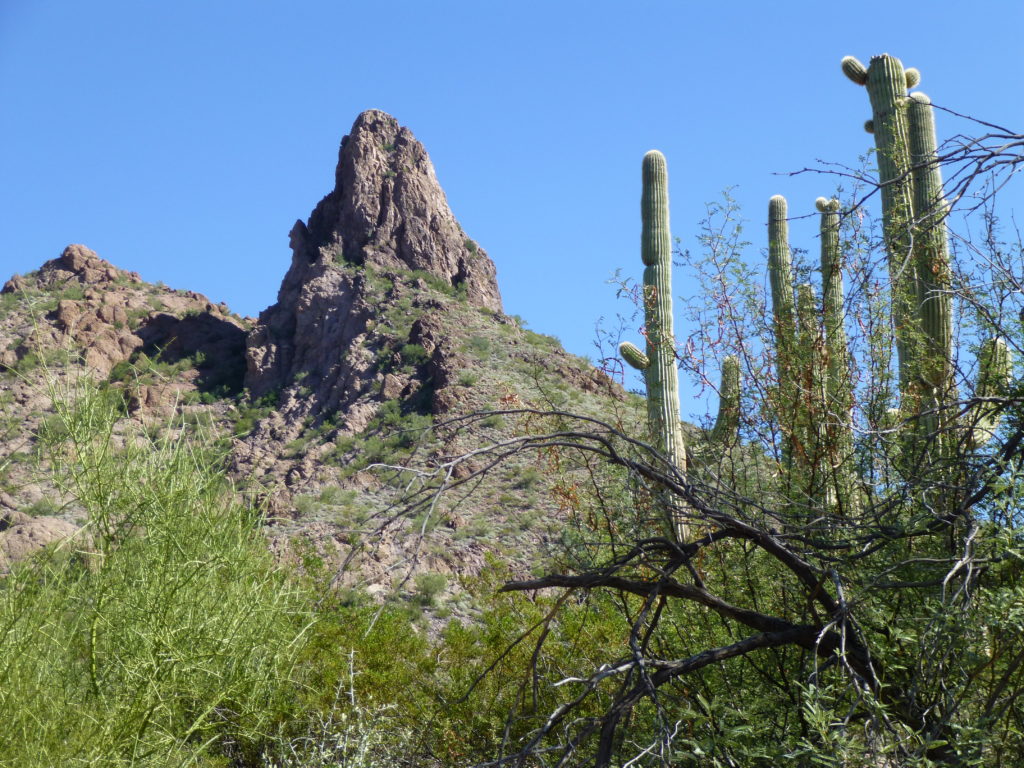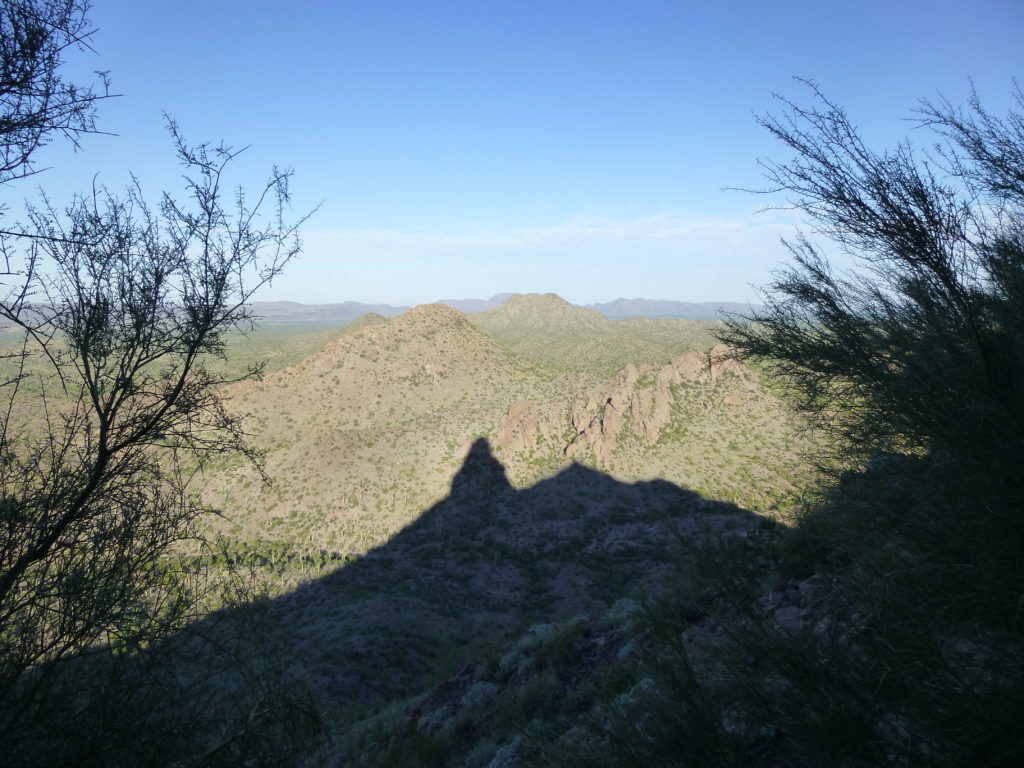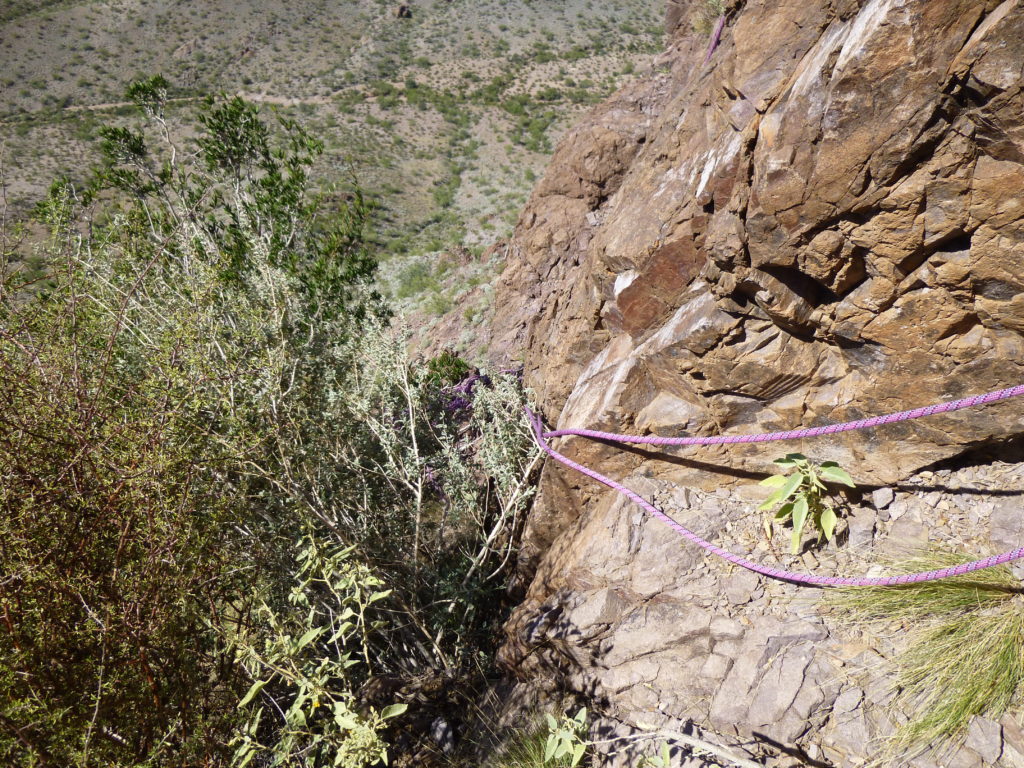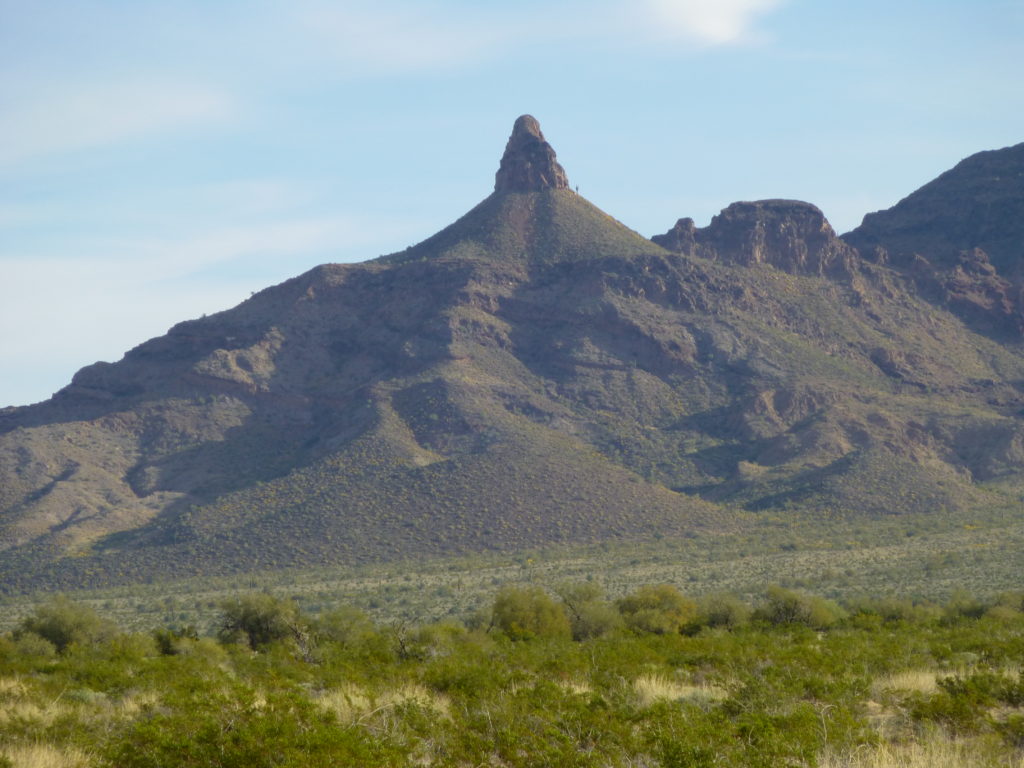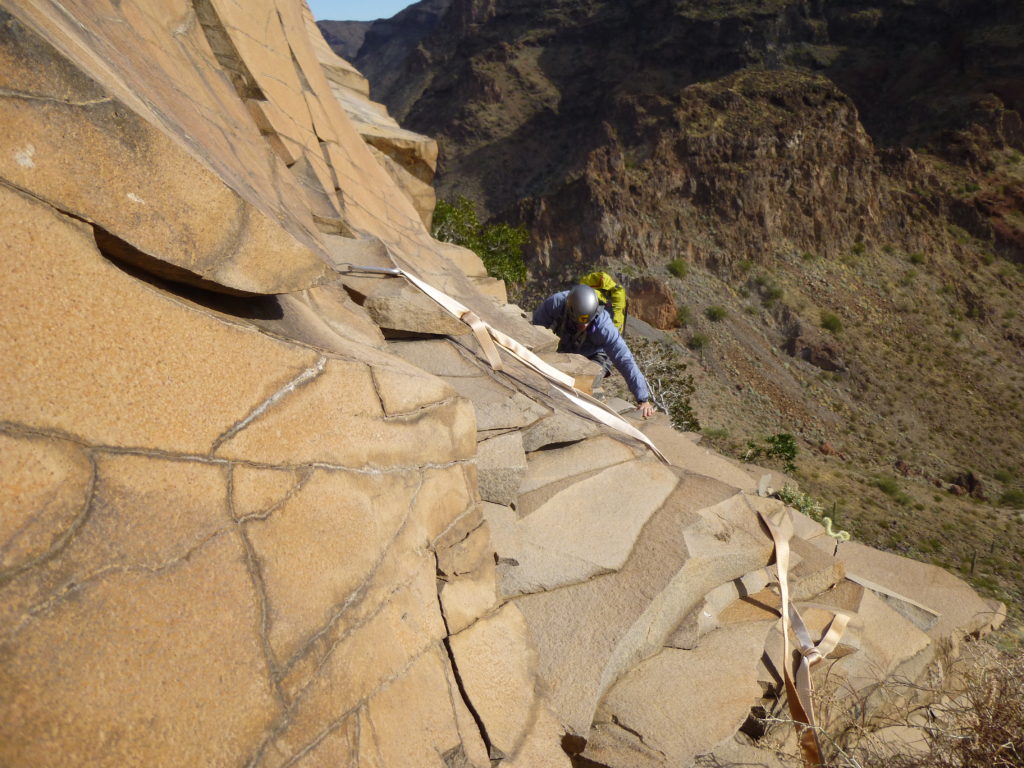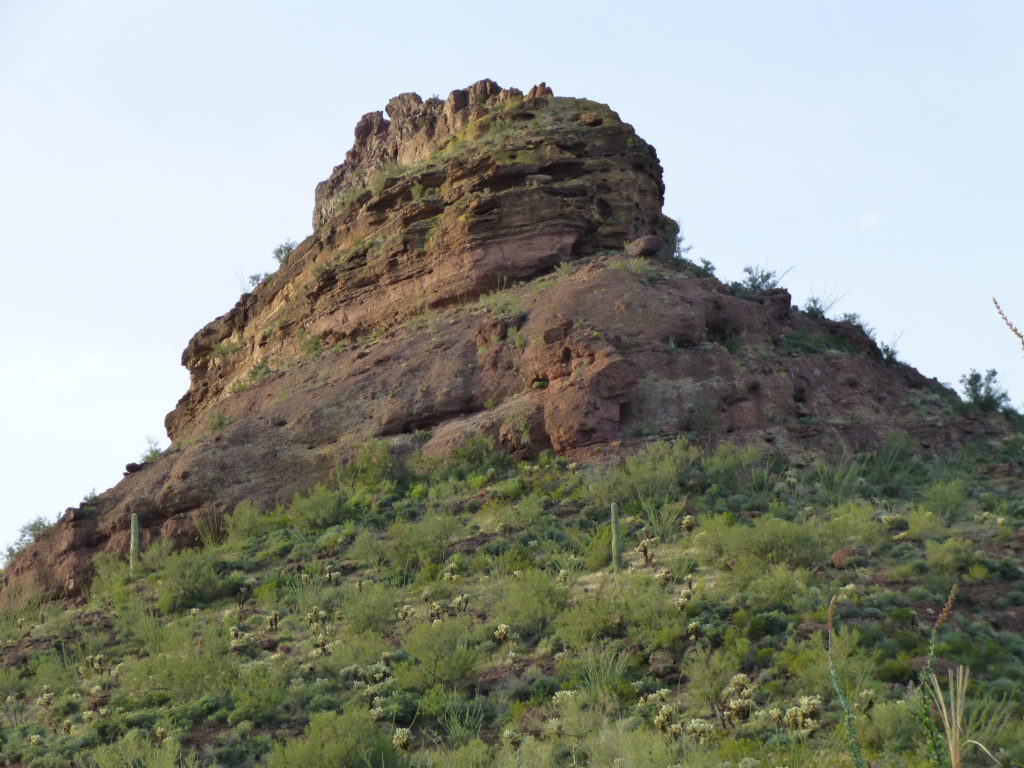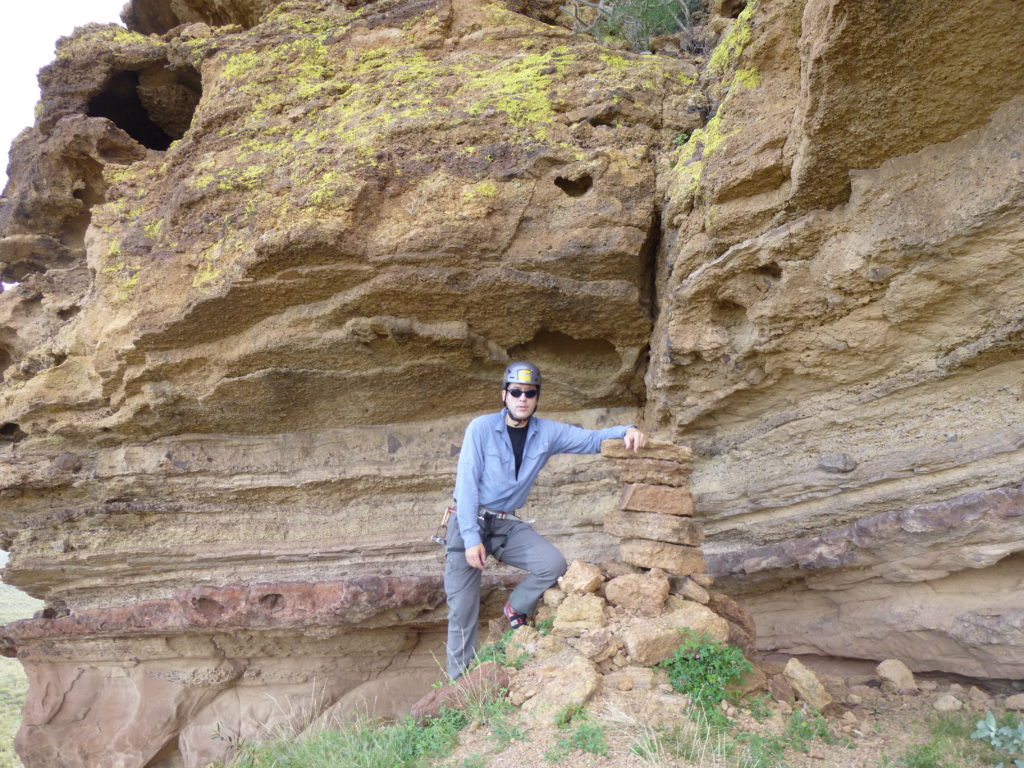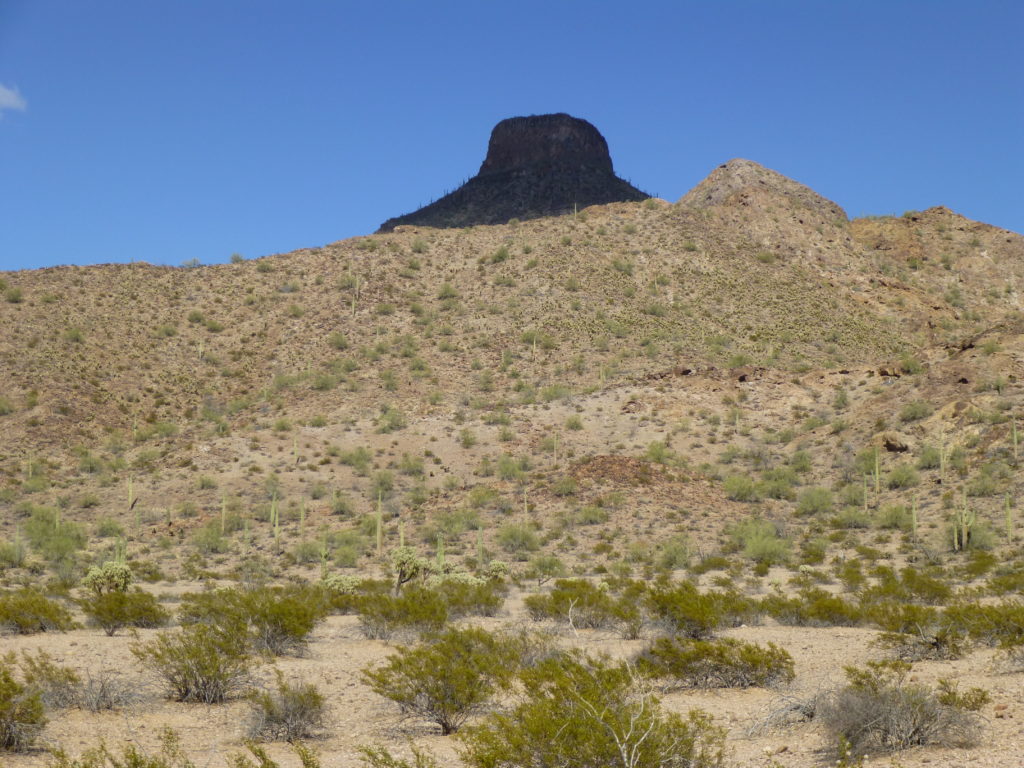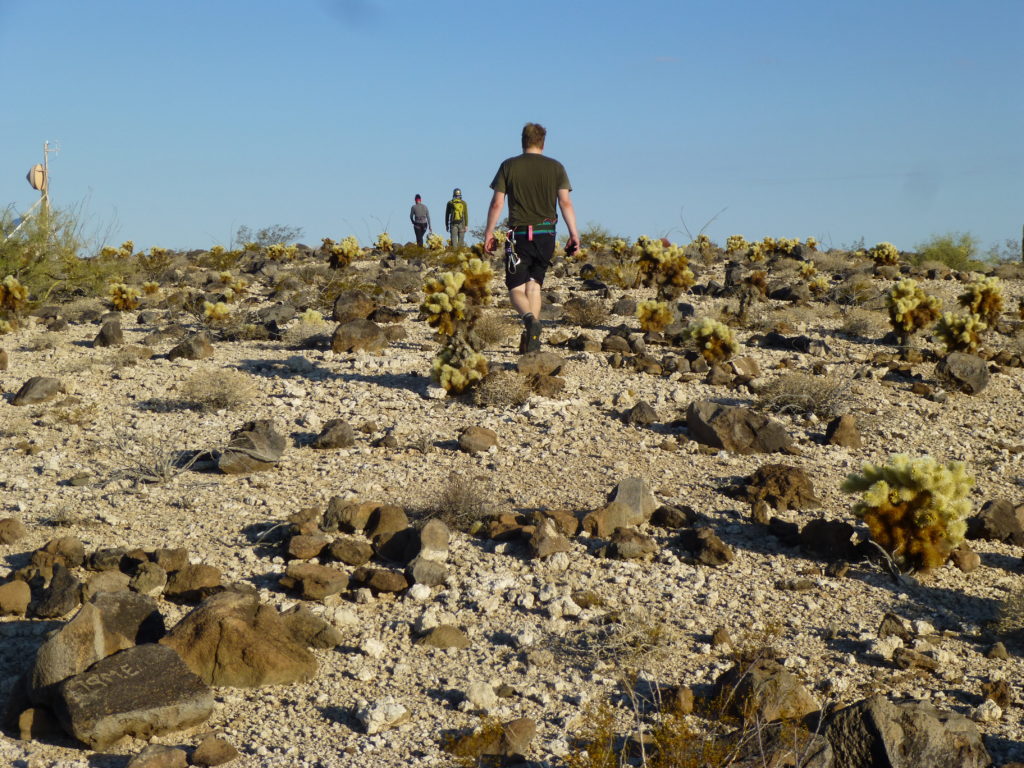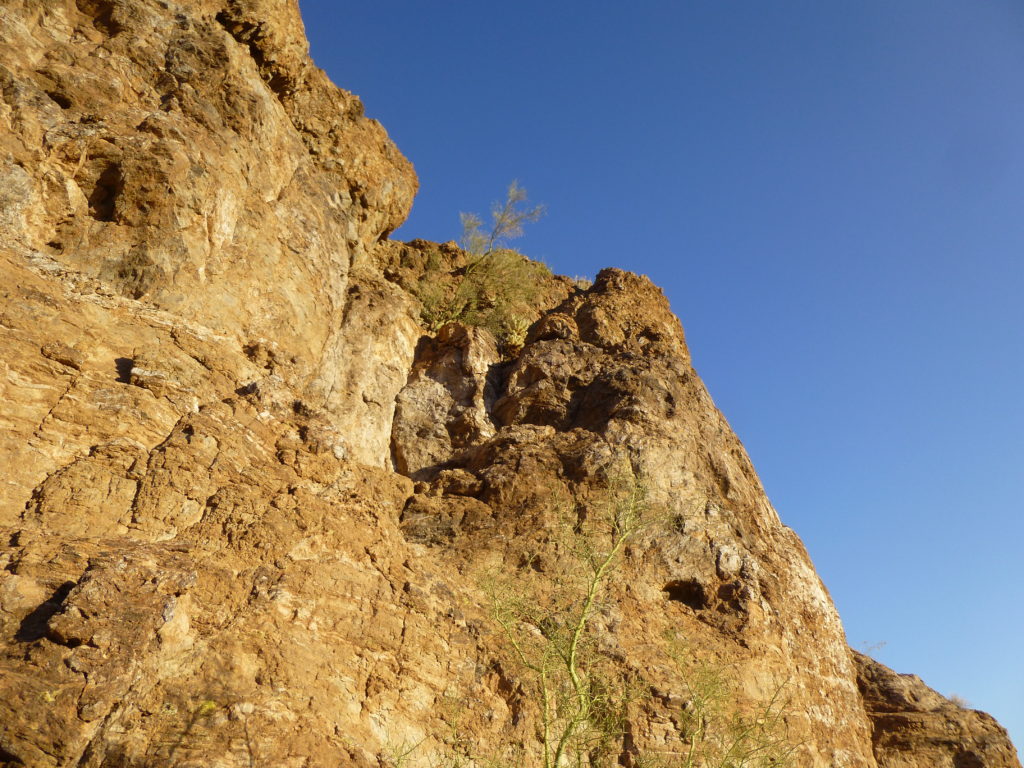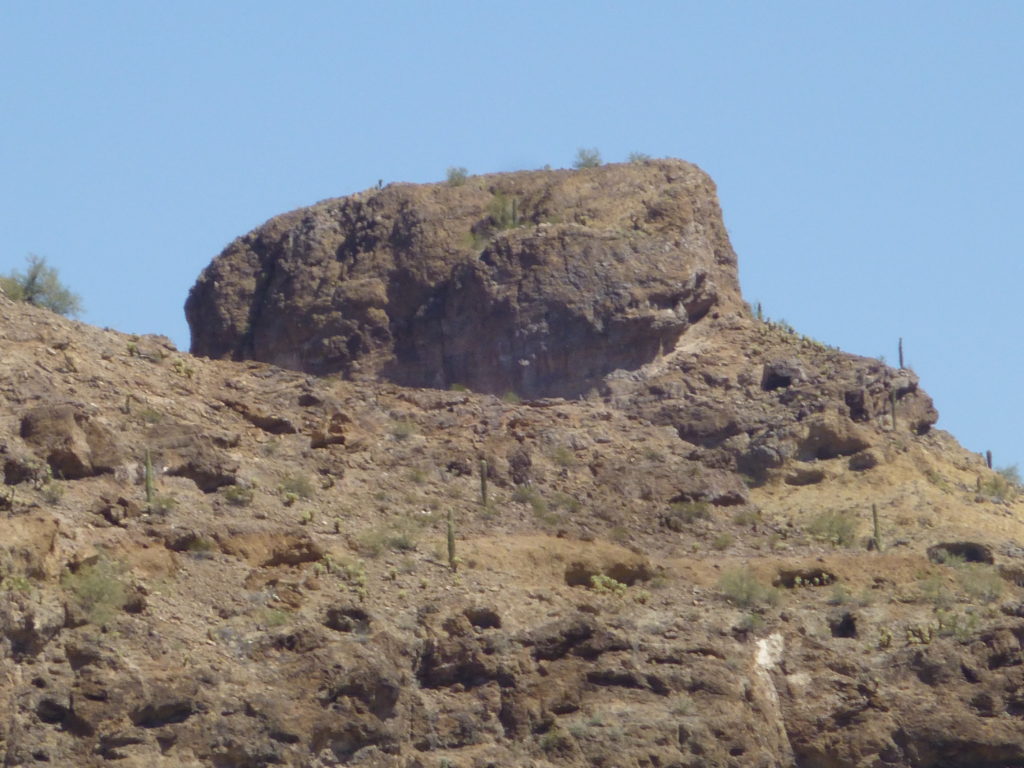Dear Andy,
I’m not sure which was the first peak we ever climbed together, but I’m guessing it may have been back in the year 2000 – we climbed Diaz Peak and Diaz Spire with climber friends from California.
Over the years, we climbed a lot of other peaks together, but there was something that distinguished many of the climbs we did – even our climber friends noticed it. My wife Dottie did too – in fact, she became suspicious every time I would go out and climb with you, knowing that it would involve a technical climb of some sort. Eventually I gave up trying to sugar-coat those outings because she saw right through me, and I’d end up promising her I’d be especially careful.
As you read through this article, when you click on any of the blue links, it will pull up a window which will give you access to a lot of other information. It may show you pictures of the peak, a map and possibly trip reports. One of the trip reports could be mine, so if you click on it you may be able to read an account of the entire climb.
Only a few months after Diaz, you and I were out once again with the same Californians, and this time it was to climb a big peak on the edge of Organ Pipe National Monument. It was Peak 4088, but for some reason we called it Montezuma Peak. It was 1,600 vertical feet of desert beauty, and we were excited because we thought it was probably unclimbed. The higher we went, the steeper things became, until we found ourselves winding our way around the summit pinnacle. Finally, there we were just below the summit – the exposure was breathtaking. Three of us wanted a belay those last few feet, while you and Dave were fine with all of that and scrambled up on your own. That was the first time you and I were on a rope together, however briefly.
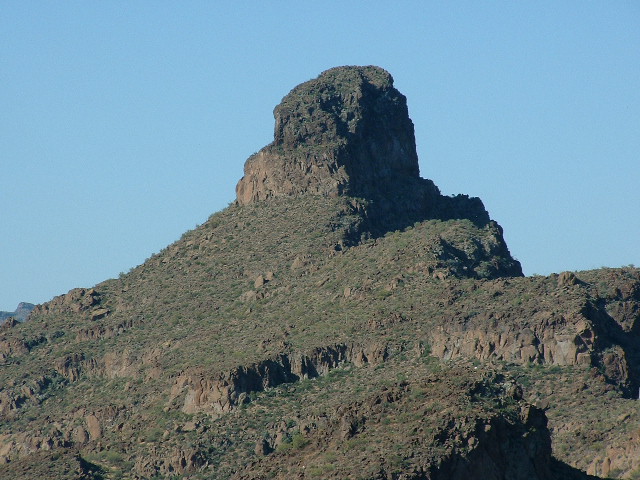
Peak 4088. We are looking at the north side of the mountain. Our route went up the left side and disappeared around the back side of the peak along that big step half-way up the steep part.
It wasn’t until 2004 until we tried another technical climb again. You had returned to Tucson from a few years absence and were anxious to get out and have some climbing fun. I was game too, so much so that we decided to head out on June 29th. This was quite insane, really – June is our hottest month in the desert and we knew we’d be tempting fate. There’s a beautiful little range out on the reservation called the Castle Mountains. I’m guessing the name comes from the fantastic shapes of some of the rocky towers. Anyone who’s driven Highway 34 passes right below some of the best ones and can’t help but be impressed. We got out there before sunrise, covered by my permit arranged in advance, and tromped over to the first one, Peak 3010. It was a quick climb, one short bit of Class 5.1, and we soon found ourselves on top.
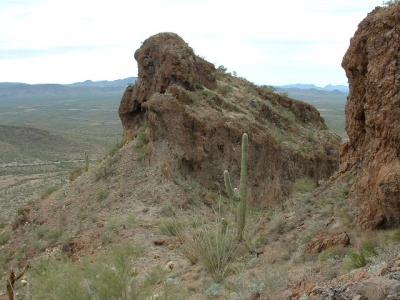 Here’s a view from the side. The peak is the one in the middle of the photo, farther away. Our route went up the left side. |
After a quick rappel down, we made the trek over to nearby Peak 3050. This was one messy, convoluted mountain and it took us a while to find a possible route that might lead to the summit. There were a lot of dead ends as we explored the upper part of the peak. The crux was a Class 5.7 move, after which it was a straightforward scramble to the top. Even the way back to our vehicle was complicated in the hundred-degree heat, but in the end we made it back safely to the air-conditioned comfort of the ride home. I can’t help but marvel every time I pass these peaks that we actually pulled it off.
Late the following year, you and I spent the entire Thanksgiving weekend attempting an outrageous climb of what had been dubbed The Ugly Sister. We made a full frontal assault on the south face, and although we didn’t make the summit, we got high up on the thing before running out of daylight and weekend. That peak is the 16th-steepest of the 7,500 peaks in Arizona, and I clearly remember the high point you reached late on the afternoon of the second day. It was on a frightening expanse of overhanging wall, and I knew it was way out of my league. You were game to continue, to climb into the night, but I pleaded for us to start down. As it was, we ended up rappelling into the inky night to get back down to our sleeping bags.
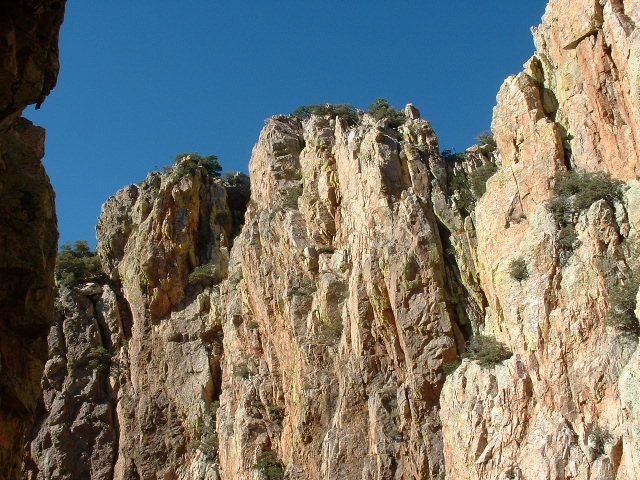
This was the uppermost part of the climb that awaited us. I drew the line here. It would have been Class 5.8 to 5.10, way beyond my ability. I had no desire to use jumars to follow you.
The next technical climb we did was smack-dab in the middle of Tucson, a little something called Beehive Peak. Climber friend Andy Martin joined us for this one, a short climb which lived up to its name, on March 31, 2006. Halfway up the north side was an active beehive in a cleft in the rock, impossible to avoid on the standard Class 5.0 route. I’m not sure how many climbers they nailed, but they sure got me the day we climbed. As I stood there in an awkward stance belaying you, I noticed a stream of bees flying between my legs. They soon lost patience and stung me a couple of times, and I was glad to be down and off the peak. There’s nothing to put the fear of God into you like angry bees.
During the summer of the following year, we did another roped climb close to home. On the north side of the Tortolita Mountains sits a peak called Owl Head Buttes North. Although small, it’s an impressive-looking thing. We went there early one morning in late July, walked over to the base of the west side and then roped up. One small problem was that here too was a very active hive of wild bees, busily flying in and out of a crevice in the rock. We had to move our belay position at the start of the climb at least once to avoid them. The climb itself was easy enough at Class 5.0, but because it was July it was hotter than a two-dollar pistol. We were glad to be done with it.
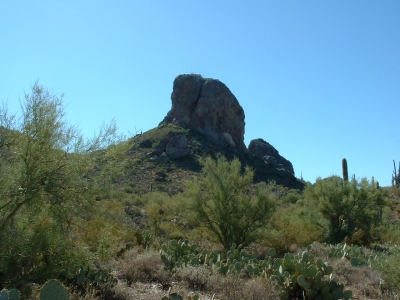 Our route went up the right side of the peak. |
Mildred Peak, south and west of Tucson down in the Baboquivari Mountains, was our next technical climb. There were 4 of us. An older gent led us up the slopes of the peak, as he’d been there before, but it proved too much for him and he waited for us lower down. The other 3 of us continued on to the summit area where we roped up. It was a quick, short climb at Class 5.1 and even though it was October 17th of 2009, seemingly-late in the year, it was still a warm day. It goes without saying that you led the climb – you polished it off quickly. It brings a smile whenever I’m in those parts and catch a glimpse of Mildred.
Less than 2 months later, we set out together to climb the best one yet. In the northeast corner of Organ Pipe Cactus National Monument sits a peak that would impress anyone. Montezuma’s Head (known as I’itoi Mo’o in the language of the Tohono O’odham people, the original inhabitants of the area) towers a full 1,600 feet above the approach desert on its west side. I knew a few who had climbed it, and talking to them made me realize that it was a serious undertaking. You and I set out from our parking spot in the darkness and made the 4-mile trek across the desert eastwards towards the peak. We crossed the lower end of Pitahaya Canyon, then scrambled up 900 vertical feet of cliffy ground, plenty of it Class 3, to a saddle at 3,050 feet. We left extra clothing, food and water there to be used on the trip back out. A couple of hundred feet more of steep scrambling brought us to the start of the real climbing. We roped up.
A drearier place to begin a climb you’d be hard-pressed to find. The sun never shines in the near-vertical shaft that is the first pitch on the NNW side of the peak. A nasty, cheerless place straight out of Mordor, a challenging spot that has been the undoing of plenty of climbers. You led it beautifully, of course, and I eventually followed. One pitch led to another until we arrived at the last. I sat beneath a large overhang belaying – you were around a corner, out of sight, while I shivered in the December breeze, wondering how your lead was going. The exposure in places on the first pitches was outrageous enough, but then came the final pitch.
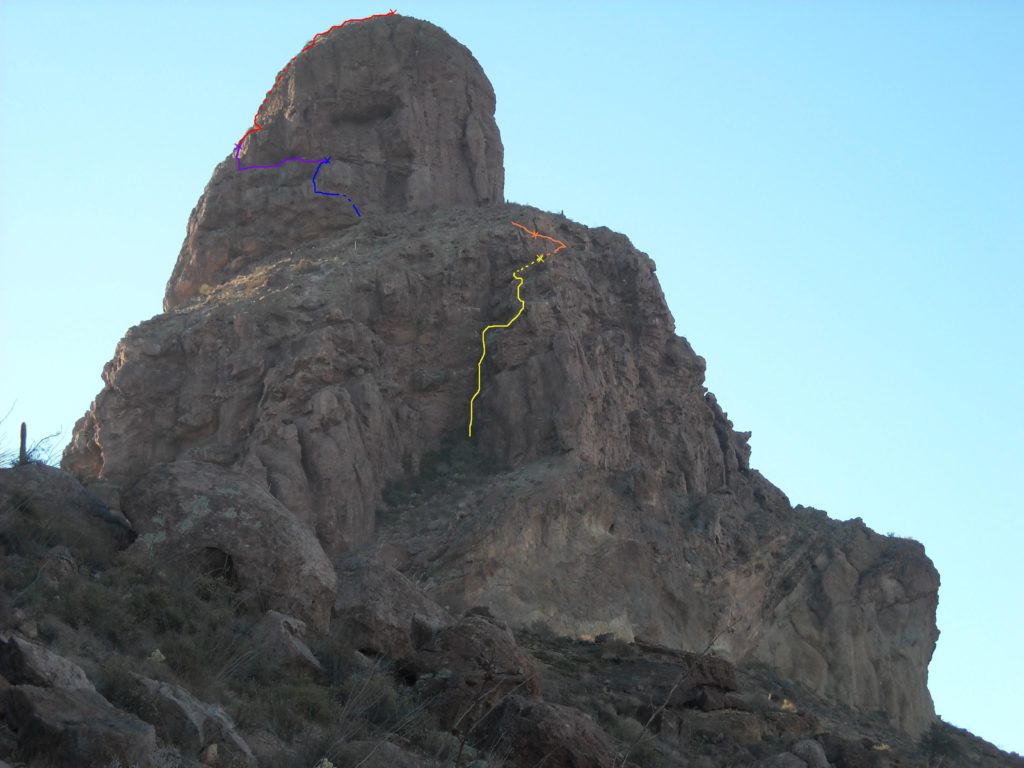
This shows the route. The gloomy first pitch is yellow. The short second pitch is in orange. Blue shows the third pitch. Purple is the fourth pitch, with its scary ending. Red marks the final pitch where I begged for a rope.
I’m not sure how other climbers feel about heights. I’ve never thought of myself as being afraid of heights, since the whole idea of climbing to a mountaintop is all about being up high. However, that day, December 10th, I had the crap scared out of me. You were out of sight around the corner tying into some hangers at the end of the pitch – we could barely communicate, I had no idea what you were doing, and I was preparing myself for the worst. Finally, you brought me up to you and my worst fears were realized. I had to step across a gap which took my breath away – the entire east face dropped vertically below my feet and it was dizzying. Soon after that, I climbed up a bit more, then up a final 10 feet, vertical, of Class 5.7+ to reach you. There you were, practically hanging off of 2 bolts directly above all of that verticality with a huge grin on your face. When I reached you, I clipped in to the protection that was there and was completely un-nerved. You said “That’s it, we’re done.” Nope, not in my opinion were we done. I was so wigged out with the exposure of the place that I begged for a belay on the last hundred vertical feet of 60-degree slope.
Well, we made it to the rounded summit and signed in to the register. It was 3:00 PM, and I was so nervous about all of the exposure on the climb that I couldn’t even enjoy the fact that we had reached the top safe and sound. I asked you if we could start down right away, please, before we were benighted on the mountain. You agreed. We rappelled one pitch after another and made it back down to our waiting gear by 5:45 PM as the sun set. Your headlamp died, and with just mine we negotiated our way down the 900 vertical feet of brushy, rocky ground to the desert floor. Four more miles of flat desert walking, much of it by starlight, and we were back at our vehicle 14 hours after starting out. You sure did put up with a lot of my whining that day, and I’m grateful.
Montezuma’s Head scared me more than any climb I’ve ever done, but the next one we did proved to be the most difficult. Less than 2 months later, we went after a real prize. In a remote corner of the military bombing range sits an outrageously steep peak with no weaknesses. It had foiled earlier attempts, so we weren’t sure what to expect on January 30th of 2010 when we paid a visit to Tom Thumb. At first blush, when you view it from the west, you’ll wonder if your eyes are playing tricks on you. This mountain gives no quarter to anyone, period.
It’s a long drive to get to a place where you can park for Tom Thumb, and by the time we stood at the base of the climb it was already 11:00 AM. I had you on belay a while later and up you went, soon disappearing from sight. After some time, reappearing higher up, you reached a safe spot and set up a secure anchor to bring me up. However, before I started to climb, you called down to me and said that you had good news and bad news. I asked for the good news, and you said that from where you were it was an easy finish to reach the top. Okay, that was good to hear, but the bad news was that I couldn’t climb up by the route you’d taken – it was too dangerous. The only route I could take was one that went straight up from my stance, up some vertical and then overhanging rock. How could that possibly work out, my going up a route that you had decided against taking yourself?
Well, to make a long story even longer, by some miracle I managed to get up the overhanging part. It was definitely the most difficult technical climbing I’ve ever done. How hard was it? Certainly harder than any of the other Class 5.7 climbs I’d ever done with you. Once I was up to where you were waiting, the rest of the climb was easy, with nothing worse than exposed Class 3. I was curious to see what the summit looked like, but it appeared untouched. We were the first to set foot on it, and that was a great feeling. We left a register, enjoyed our accomplishment for a while, then scrambled back down to where you’d belayed me. It was a simple rappel from there down to the bottom of the climb where we’d left the rest of our gear.
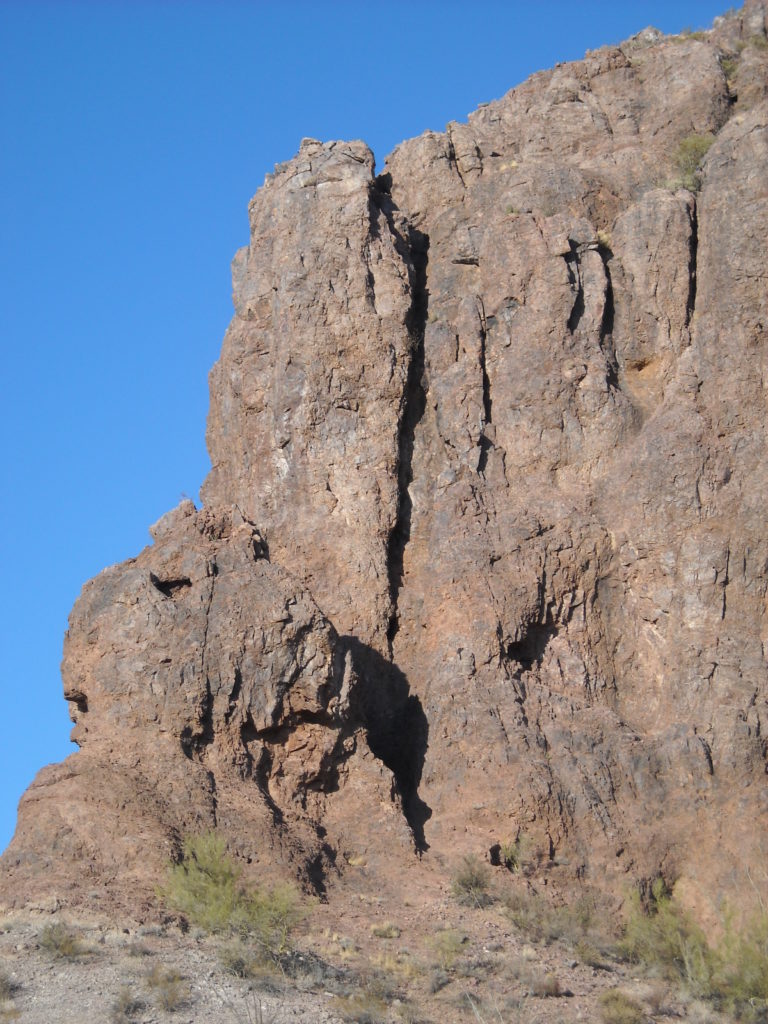
The route I had to climb was straight up the dark crack right up the middle of the photo to the skyline.
During the Thanksgiving weekend we’d spent at the Ugly Sister, you had regaled me with stories of other climbs. One which really stood out in my mind was a peak called Courthouse Rock, out in the desert an hour’s drive west of Phoenix. Well, wouldn’t you know it, it became our next project. A few months later, April 17th to be exact, we found ourselves heading out there to climb it. You’d already done it, but kindly agreed to go back and lead me up it. Mid-April in that location can easily top a hundred degrees, so even though we started on foot at first light, we were pushing our luck. Ours was the standard route, rated a Class 5.5, and I really enjoyed it. I thought the rock was excellent, and some of it was oh-so-vertical, but it went really well. It’s a popular climb with the folks from nearby Phoenix, so it had seen a lot of action over the years. We ran out of water before we were done, while still high up on the Rock, and I can’t tell you how glad I was to make it down to your truck, where we had water and air-conditioning.
Years passed. I was working on completing a major list of peaks, and once again I enlisted your help. Less than 4 miles from the town of Ajo, Arizona sits a rocky tower known as Ajo Peak, which is quite impressive to look at.
Neither of us had ever been there before but both of us had admired it from afar. We camped nearby, and at first light on October 18, 2014 we walked around to the south side of the peak – this would be the only reasonable line of attack. Here is the peak from down below – our route went up the right-hand skyline.
Certain clear memories persist about this one – it was a fairly short climb, the rock was good and it was really steep. Here’s a picture I took part-way up the climb – the shadow shows how steep it was.
The top was so small that when the 2 of us sat there together, it made me downright nervous. After a short while, we started down. Here’s a photo of our rope, ready for us to tie in and rappel down. This spot is near the crux of the climb, and the upper left part of the photo shows the desert floor six hundred feet below. This was a memorable and enjoyable climb.
In 2002, you and some of our California climber friends had gone in to have a look at a remote desert peak. It looked pretty technical, and you didn’t have the proper gear to safely try it. It turned out that this mountain was on one of my lists, and climbing it was a must-do for me. In late 2013, you and I made the trek to the peak to give it a try, and we did have the right gear. However, we ran out of the time we needed for you to bring me up. You unroped and scrambled the last of the way to the summit, as that was possible in the bit of daylight we had left. Sure, I was disappointed, but happy that you’d made it.
A year later, we went back in a few days before Christmas, this time with a third man. We started earlier, moving by 4:00 AM in the pitch dark. It’s a long stomp to get in there, and by the time we reached the base of the actual roped climbing the sun had risen. The day was perfect – cloudless, calm, warm. It was about 7:30 AM by the time we were roped up and you led up the first pitch. It was quick work for you to gain a hundred feet with nothing worse than Class 5.6. That put you on a wide, sloping ramp, the same spot you’d been a year before when you and I tried the climb. Back then, you couldn’t place an anchor safe enough to bring me up. What would happen this time?
You’d had a whole year to replay this in your mind. The mountain was still the same, so what would you do differently this time? You spent 2 full hours examining every possible option, then called us on the radio to say that we were on belay. I went next, then John, and I don’t think either of us expected what we found when we reached you. Here’s a shot of John coming up to the spot where your belay was set up. This wasn’t much of a place to hang out for any length of time. Sloping outwards and down like it did, it was scary.
Once we climbed up to you, it was easy to see why it had taken so long to set up a belay – there was nothing to work with! From there, we unroped and scrambled up to the end of the ramp, then turned 180 degrees and made our way up the steep, narrow ridge to the summit. It was only Class 2, but the exposure was breathtaking. On the summit sat something curious – a large piece of PVC pipe with a cap on its end. Inside it was a a waterlogged paper, moldy and illegible. This is something that military personnel would leave after landing on the summit in a helicopter. Climbers would not carry such a register so far, and would not make a register like that in the first place. Credit for the first ascent must therefore go to Andy, and the 3 of us share in the second ascent.
Remember Montezuma’s Head? Well, just north of it and way down on the desert floor sits a little peak we call 2725. One party had tried it before but had struck out. We walked in the few miles and found ourselves at its base. Here’s what it looked like – our route would go up the right-hand skyline.
The same 3 of us as on Sheep Peak were here. John went up to explore and found what looked like the only logical route. Its start was unusual. The only previous party, back in the year 2000, had failed because they couldn’t get past the first move. The original party had stacked rocks up 4 feet high to help them begin, but it wasn’t enough.
The first 12 feet was overhanging. Andy, you led, making it look easy. I went next, standing on top of the pile of rocks, then John gave me a boost to get me over the worst of the overhang. It wasn’t pretty, but it did the job and I soon made my way up to you. John easily followed. Minutes later, we were on top of Peak 2725, and as we expected, it appeared untouched. After leaving a register, we went back down and rappelled the last part. The next part of our day involved a climb of Peak 2602 right next door to the north, a really cool Class 4 with plenty of exposure which we did unroped.
Another year and a half passed. A striking peak in the Sauceda Mountains had been nagging me for a long time, and finally came the day to go and climb it. This time, you led 3 of us up Hat Mountain on the bombing range.
Once again, you had been there before, 15 years earlier. The only catch was that your schedule only allowed an attempt in early August. Yikes, we knew it was gonna be hot – they predicted a high of 107 degrees that day. We met in the closest town at three in the morning, then drove down to the peak. We set out by headlamp in the inky blackness towards the summit, thirteen hundred feet above us. As we climbed, we met a striped skunk and a black-tailed rattlesnake which kept things lively. The sun was up by the time we reached the start of the technical climbing, a mere hundred feet below the top. We made short work of this Class 5.3 climb and before you knew it, we all stood on the flat summit. We found the register and all signed in, but didn’t linger.
We all rappelled off the summit and headed down. By the time we re-gained the vehicles at 10:00 AM, it was a balmy 97 degrees – I was glad it didn’t take any longer.
This brings me to the last roped climb we did together. Almost 3 years ago, I had been out in the desert with my friend Dennis. It was May 28th, so we knew we were rolling the dice as far as temperature was concerned. It can be way over 100 degrees in that area at that time of the year. We managed to climb one peak, then drove around to start in to yet another. We got there alright, but were stumped by the steepness of the peak and had to call it quits and head home. I requested your help – it took a while, but you freed up a day in your schedule. On April 22 of 2017, you and I headed back in to try Peak 1900.
We started in with the faintest light of dawn, and by 6:40 AM stood at the base of the roped climb. This was the spot where Dennis and I had stopped the year before.
From the time I put you on belay, you were on the summit in only 17 minutes, our quickest climb ever. You brought me up and we placed a register on this untouched mountaintop, rated at Class 5.1. We rappelled down and made our way back to the truck. Here’s our view of the summit area as we walked away.
During all those years, we did climb other peaks of a non-technical nature together, sometimes with other climber friends. However, as long as I may live, I will always associate climbing with you as being on the back end of a rope. Thanks for the memories and the thrills, Andy.

